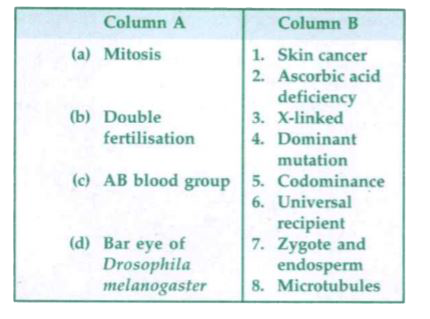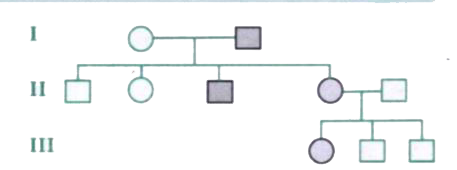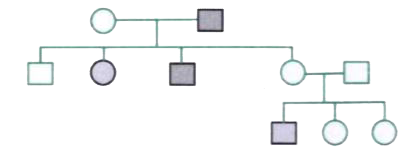Complete Solutions to ILLUSTRATIVE QUESTIONS of chapter PRINCIPLES OF INHERITANCE AND VARIATION of Class 12 book with complete answers and questions
| Class 12 | BIOLOGY |
| Chapter | PRINCIPLES OF INHERITANCE AND VARIATION |
| SRIJAN | ILLUSTRATIVE QUESTIONS |
| Number Of Questions | 60 |
| Academic Year | 2023-24 |
List any four symptoms shown by a Klinefelter syndrome sufferer. Explain the cause of this disorder.
View SolutionDefine monosomy.
View SolutionIn humans, genetically, the sex of the child is determined by the father and not by the mother. Explain.
View SolutionWhat are the advantages of using Drosophila for experiments on genetics?
View SolutionIn a testcross AaBb x aabb, 90% of the progeny is like parents. Determine:
The progeny type for rest of the population.
View SolutionIn a testcross AaBb x aabb, 90% of the progeny is like parents. Determine:
Are the genes linked?
View SolutionIn a testcross AaBb x aabb, 90% of the progeny is like parents. Determine:
Is there any crossing over between the genes?
View SolutionIn humans, genetically, the sex of the child is determined by the father and not by the mother. Explain.
View SolutionExplain how an XXY individual can arise in humans?
View SolutionIf the distance between the genes on a chromosome is as follows, prepare a genetic map and assign the correct order of genes. X-Z = 5 cm Y - Z = 3 cm X - Y = 2 cm
View SolutionColour blindness is a recessive trait. A couple with normal vision has two sons - one colourblind and one with normal vision. If the couple has two daughters, what proportion of them will have normal vision?
View SolutionFill the gaps of the following paragraph taking appropriate words from the bracket (first, second, meiosis, mitosis, 1:1, 1:2, gametes, male, female, 50%, 100%). In human beings male has XY and female has XX chromosome complement. The sex chromosomes segregate during the (a) division of (b)_____ The X-chromosome constitutes (c) _____ of produced sperms and (d)____ of eggs. If randomly mated, the ratio of sex expression is (e) _____. The sex of the offspring is determined by (f)____ of (g) _____.
View SolutionAnswer the following questions referring the data below.
Grey colour `(b^(+)//b)` , normal winged `(Vg^(+)//Vg) F_1` female X Black coloured (b/b) vestigial winged (Vg/Vg) male.
The offspring were grey normal 126, grey vestigial 24, black normal 26 and black vestigial 124.
What ratio is expected in this cross? Does the above phenotypic ratio confirm the expected ratio?
View SolutionAnswer the following questions referring the data below.
Grey colour `(b^(+)//b)` , normal winged `(Vg^(+)//Vg) F_1` female X Black coloured (b/b) vestigial winged (Vg/Vg) male.
The offspring were grey normal 126, grey vestigial 24, black normal 26 and black vestigial 124.
What is the cause of above phenotypic ratio?
View SolutionMatch the columns


View SolutionDraw the gene maps of the following:
Recombination frequency between three recessive genes present on X-chromosome of Drosophila were found to be as follows: (i) sc (scute) and ec (echinus or rough eye) = 7.6% (ii) ec and cv (cross veinless) = 9.7% (iii) sc and cv = 17.3%
View SolutionDraw the gene maps of the following:
Morgan and Strutevant found recombination frequencies between 3 genes to be as follows: (i) b (black body) and vg (vestigial wings) = 18% (ii) b and cn (cinnabar eye) = 9% (iii) on and vg = 9.5%
View SolutionA diploid organism is heterozygous for four loci, how many types of gametes can be produced?
View SolutionExplain law of dominance using a monohybrid cross.
View SolutionDefine and design a testcross.
View SolutionUsing a Punnet Square, work out the distribution of phenotypic features in the first filial generation after a cross between a homozygous female and heterozygous male for a single locus.
View SolutionTwo heterozygous parents are crossed. If the two loci are linked, what would be the distribution of phenotypic features in `F_1` generation for a dihybrid cross?
View SolutionBriefly mention the contribution of T.H. Morgan in genetics
View SolutionWhat is Pedigree analysis? Suggest how much analysis can be useful?
View SolutionA child has blood group O. If the father has blood group A and mother's blood group is B, work out the genotypes of parents and the possible genotypes of other offspring.
View SolutionMention any two autosomal genetic disorders with their symptoms.
View Solution"Genes contain the information that is required to express a particular trait. Explain

View SolutionIn our society a woman is often blamed for not bearing male child. Do you think it is right? Justify.
View SolutionColourblindness is more frequent in males as compared to females. Comment.
View SolutionIf a father and son are both defective in red green colour vision, is it likely that the son inherited the trait from his father? Comment
View SolutionWhy did Morgan observe complete linkage in male Drosophila but not in female Drosophila?
View SolutionPure lines and clones do not exhibit genetic variations for natural selection. Why?
View SolutionSexual reproduction contributes to continuous variations in cross breeding populations, how?
View SolutionWhy is male sex called hemizygous in man and Drosophila?
View SolutionWhy are sperm and ova said to be the connecting link between two consecutive generations?
View SolutionT.H. Morgan while going on walk, found a fruit covered with flies. He took the flies to the laboratory. He performed experiments for several generations and was surprised to observe that some characters do not obey Mendelian principle of independent assortment.
Write the common name and the scientific name of flies.
View SolutionT.H. Morgan while going on walk, found a fruit covered with flies. He took the flies to the laboratory. He performed experiments for several generations and was surprised to observe that some characters do not obey Mendelian principle of independent assortment.
What is the cause of this phenomenon?
View SolutionT.H. Morgan while going on walk, found a fruit covered with flies. He took the flies to the laboratory. He performed experiments for several generations and was surprised to observe that some characters do not obey Mendelian principle of independent assortment.
Fill in the blanks: The tendency of certain traits of two characters to be inherited together generation after generation is called __. The tendency of traits of two characters to separate in certain generations is______.
View SolutionT.H. Morgan while going on walk, found a fruit covered with flies. He took the flies to the laboratory. He performed experiments for several generations and was surprised to observe that some characters do not obey Mendelian principle of independent assortment.
Draw the diagram of physical basis of this type of inheritance.
View SolutionIn Antirrhinum RR is phenotypically red, rr is white and Rr is pink. Mention the phenotype and the ratio in F1 generation of the following crosses: (i) RR X Rr (ii) rr RR (iii) Rr x Rr (iv) rr x Rr .
View SolutionName the other plant which shows similar type of inheritance. Give the scientific name.
View SolutionThe given figure of a human shows a pedigree analysis. Answer the following questions based on the figure.

In the pedigree which character is represented?
View SolutionThe given figure of a human shows a pedigree analysis. Answer the following questions based on the figure.

In the pedigree which character is represented?
View SolutionThe given figure of a human shows a pedigree analysis. Answer the following questions based on the figure.

Which one is heterozygous, male or female? Give reason.
View SolutionThe given figure of a human shows a pedigree analysis. Answer the following questions based on the figure.

In the pedigree which character is represented?
View SolutionThe given figure of a human shows a pedigree analysis. Answer the following questions based on the figure.

What is the probability of the disorder occurring in fifth child?
View SolutionStudy the given pedigree chart and answer the following questions:

Is the trait recessive or dominant?
View SolutionStudy the given pedigree chart and answer the following questions:

Is the trait sex-linked or autosomal?
View SolutionStudy the given pedigree chart and answer the following questions:

Give the genotypes of the parents shown in generation I and their third child shown in generation II and first grand child shown in generation III.
View SolutionStudy the given pedigree chart and answer the questions that follow:

Is the trait recessive or dominant?
View SolutionStudy the given pedigree chart and answer the questions that follow:

Is the trait sex-linked or autosomal?
View SolutionStudy the given pedigree chart and answer the questions that follow:

Give the genotype of the parents in generation I and their third and fourth child in generation II.
View SolutionHaemophilia is a sex-linked recessive disorder of humans. The given pedigree chart shows the inheritance of haemophilia in one family. Study the pattern of inheritance and answer the questions given.
(a) Give all the possible genotypes of the members 4, 5 and 6 in the pedigree chart. (b) A blood test shows that the individual 14 is a carrier of haemophilia. The member number 15 has recently married the member numbered 14. What is the probability that their first child will be a haemophilic male?

View SolutionA child has PKU disorder, but neither parent has PKU. What is the genotype of the parents? Give reason for your answer.
View SolutionWhat is polyploidy?
View SolutionHow can polyploidy be induced in flowering plants?
View SolutionName some plants in which polyploidy has been induced experimentally
View SolutionWhy is polyploidy common in plants but not in animals?
View SolutionSickle-cell anaemia as well as thalassemia are autosomal recessive diseases.
What do the terms autosomal and recessive mean?
View SolutionSickle-cell anaemia as well as thalassemia are autosomal recessive diseases.
Why are these diseases more common than expected in certain areas?
View Solution
ILLUSTRATIVE QUESTIONS questions and complete solutions for chapter PRINCIPLES OF INHERITANCE AND VARIATION of SRIJAN BIOLOGY (ENGLISH) of Class 12
All Exercises from SRIJAN Class 12 BIOLOGY PRINCIPLES OF INHERITANCE AND VARIATION
- COMPETITION CORNER (OBJECTIVE TYPE QUESTIONS (ASSERTION AND REASON TYPE QUESTIONS))
- COMPETITION CORNER (OBJECTIVE TYPE QUESTIONS (MULTIPLE CHOICE QUESTIONS))
- ILLUSTRATIVE QUESTIONS
- MULTIPLE CHOICE QUESTION
- PRACTICE QUESTIONS ( LONG ANSWER TYPE QUESTIONS)
- PRACTICE QUESTIONS ( SHORT ANSWER TYPE-I QUESTIONS)
- PRACTICE QUESTIONS ( SHORT ANSWER TYPE-II QUESTIONS)
- PRACTICE QUESTIONS ( VERY SHORT ANSWER TYPE QUESTIONS)
- PREVIOUS YEAR.S BOARD PAPER QUESTIONS ( LONG ANSWER TYPE QUESTIONS)
- PREVIOUS YEAR.S BOARD PAPER QUESTIONS ( SHORT ANSWER TYPE-I QUESTIONS)
- PREVIOUS YEAR.S BOARD PAPER QUESTIONS ( SHORT ANSWER TYPE-II QUESTIONS)
- PREVIOUS YEAR.S BOARD PAPER QUESTIONS (VERY SHORT ANSWER TYPE QUESTIONS)
- REVIEW QUESTIONS